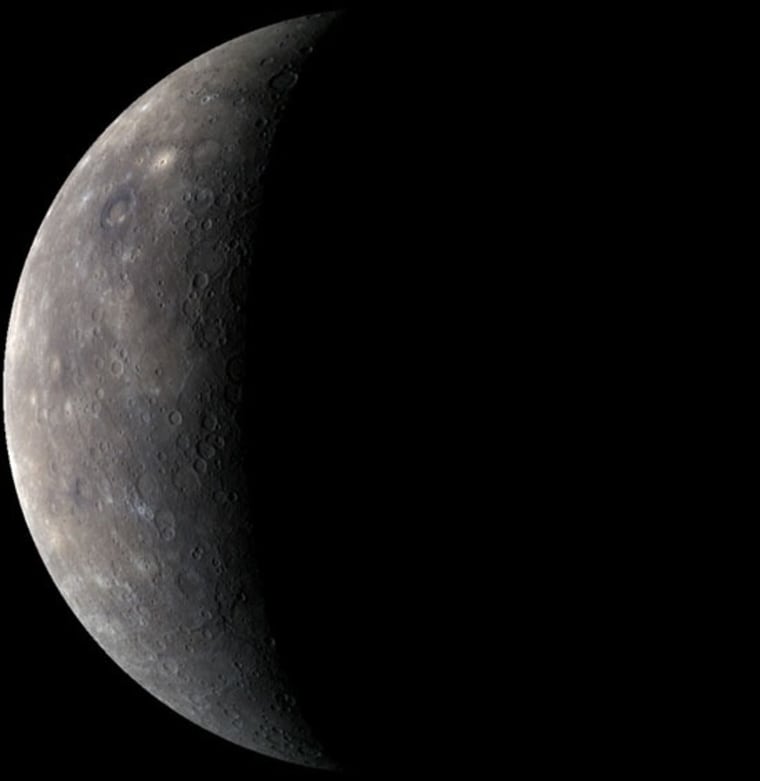A NASA spacecraft has spotted what appears to be changing seasons on Mercury and found much more iron on the surface of the small, rocky planet than previously thought.
The MESSENGER probe made the observations during its third flyby of Mercury on Sept. 29, when it took a host of measurements and images of the innermost planet's surface and atmosphere. Only about half of the planned measurements were made because of a data glitch that affected the spacecraft during the flyby.
The $446 million probe's third flyby brought it within 142 miles (228 km) of Mercury's surface to cover more uncharted terrain, leaving 98 percent of the planet now mapped. The flyby was also a gravity assist meant to guide the spacecraft into orbit around the planet in 2011.
Tenuous exosphere
Mercury's atmosphere is what scientists call an "exosphere," and is made up of atoms kicked up from the surface. It is very tenuous and has a very low density, meaning atoms in the atmosphere rarely run into each other. It also has a tail that streams away from the planet in the opposite direction of the sun.
MESSENGER looked at differences in three atoms in the exosphere — sodium, calcium and magnesium — between the probe's three flybys. They detected much less sodium during the third flyby than they had during the second.
"While this is dramatic, it isn't totally unexpected," Vervack said. This is because radiation pressures from the sun change as Mercury moves through its orbit, which changes the amount of sodium liberated from the surface.
In essence, Mercury's atmosphere experiences seasonal effects during the planet's orbit.
Calcium and magnesium showed less variation between "seasons" than did sodium, showing that different atoms "are going to have their own unique seasonal varations," Vervack said.
Understanding these seasonal differences will help scientists understand how surface material is lost and how the surface has changed over time.
Mercury's atmosphere is "the end product of a few billion years of these processes, they never stop," said mission scientist Ronald Vervack, Jr., of The Johns Hopkins University Applied Physics Laboratory (JHUAPL) in Laurel, Md.
Surface surprises
The MESSENGER flybys also provided the first direct measurements of the amounts of certain elements on Mercury's surface.
Mercury's surface has long thought to be deficient in the heavy metals iron and titanium on the basis of earlier observations, an ironic make-up considering that its heavy iron core makes up an estimated 60 percent of the planet's mass and makes it the densest of the solar system's rock planets.
MESSENGER's observations show that Mercury's surface actually possesses relatively high numbers of these elements — similar to the concentrations in the moon's nearside maria basalts — which could mean that models on the planets formation and evolution will need to be revised.
Slideshow 12 photos
Month in Space: January 2014
"That's a pretty exciting result for us," said David Lawrence, also of JHUAPL.
The third flyby also yielded new images of the surface that fill in as-yet unobserved areas. The spacecraft's cameras and instruments collected high-resolution and color images unveiling another 6 percent of the planet's surface never before seen at close range.
"We've done a good job on filling in most of that map," said Brett Denevi, imaging team member and postdoctoral researcher at Arizona State University in Tempe.
The flyby garnered images of a feature seen before, but not in enough detail to characterize it. It appears to be a bright area surrounding an irregular depression, with steep sides and an odd shape, "all of which are hallmarks of something like a volcanic vent," Denevi said.
Other images revealed a double-ring impact basin approximately 180 miles across. The basin is similar to a feature scientists call the Raditladi basin, which was viewed during the probe's first flyby of Mercury in January 2008.
"One similarity to Raditladi is its age, which has been estimated to be approximately one billion years old. Such an age is quite young for an impact basin, because most basins are about four times older," Denevi said. "The inner floor of this basin is even younger than the basin itself and differs in color from its surroundings. We may have found the youngest volcanic material on Mercury."
The spacecraft has completed nearly three-quarters of its 4.9-billion-mile journey to enter orbit around Mercury. The full trip will include more than 15 trips around the sun. In addition to flying by Mercury, the spacecraft flew past Earth in August 2005 and Venus in October 2006 and June 2007.

